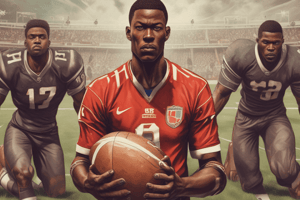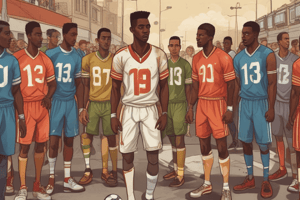Podcast
Questions and Answers
What was the main purpose of the slave patrols in the US South?
What was the main purpose of the slave patrols in the US South?
- To organize community events for slaves
- To conduct agricultural inspections
- To enforce curfews on free Black individuals (correct)
- To monitor slave education programs
What were lantern laws in 18th century New York City designed to enforce?
What were lantern laws in 18th century New York City designed to enforce?
- That all people carry flashlights at night
- That only families with children could go out at night
- That Black, Indigenous, and mixed-race individuals carry lanterns when unattended by a White escort (correct)
- That no one could walk the streets at night
What was a major consequence of the State of Exception in the context of racial surveillance?
What was a major consequence of the State of Exception in the context of racial surveillance?
- It created new forms of racial surveillance and racialization (correct)
- It led to increased rights for racial minorities
- It established a more equitable immigration system
- It encouraged judicial independence
What justification has typically been used for increased surveillance at the US-Mexico border?
What justification has typically been used for increased surveillance at the US-Mexico border?
Which group was primarily targeted through cocaine laws based on radicalized fears?
Which group was primarily targeted through cocaine laws based on radicalized fears?
What aspect of drug laws is highlighted in their relation to racial communities?
What aspect of drug laws is highlighted in their relation to racial communities?
Which of the following best describes the function of modern surveillance?
Which of the following best describes the function of modern surveillance?
What is a consequence of the 'war on drugs' in terms of surveillance?
What is a consequence of the 'war on drugs' in terms of surveillance?
How has increased distrust of the poor influenced government actions?
How has increased distrust of the poor influenced government actions?
What stereotype is often used to demonize welfare recipients?
What stereotype is often used to demonize welfare recipients?
Which of the following justifications has contributed to increased policing in poor neighborhoods?
Which of the following justifications has contributed to increased policing in poor neighborhoods?
What impact does big data have on those living in poverty?
What impact does big data have on those living in poverty?
What must individuals agree to in order to receive welfare benefits?
What must individuals agree to in order to receive welfare benefits?
Why is it often difficult for the poor to secure good jobs or loans?
Why is it often difficult for the poor to secure good jobs or loans?
What type of information is commonly used by companies to evaluate job applicants?
What type of information is commonly used by companies to evaluate job applicants?
Which of the following is NOT an example of surveillance individuals might agree to receive welfare benefits?
Which of the following is NOT an example of surveillance individuals might agree to receive welfare benefits?
How do algorithms contribute to cycles of poverty for marginalized individuals?
How do algorithms contribute to cycles of poverty for marginalized individuals?
What advantage do wealthy individuals have concerning privacy disclosures?
What advantage do wealthy individuals have concerning privacy disclosures?
What role do private clubs like the Bohemian Grove play in society?
What role do private clubs like the Bohemian Grove play in society?
Which statement best reflects the nature of surveillance capitalism as discussed?
Which statement best reflects the nature of surveillance capitalism as discussed?
What is one method that wealthy individuals use to maintain their privacy?
What is one method that wealthy individuals use to maintain their privacy?
How do wealthy individuals avoid public surveillance technologies?
How do wealthy individuals avoid public surveillance technologies?
What is a core element of elite theory?
What is a core element of elite theory?
What is one consequence of the increased surveillance of the poor?
What is one consequence of the increased surveillance of the poor?
What is a potential effect of sousveillance according to the authors?
What is a potential effect of sousveillance according to the authors?
What is a major limitation of sousveillance mentioned in the content?
What is a major limitation of sousveillance mentioned in the content?
Which statement best describes the impact of lack of collective action among surveillance critics?
Which statement best describes the impact of lack of collective action among surveillance critics?
What is one consequence of increased welfare surveillance on recipients?
What is one consequence of increased welfare surveillance on recipients?
What is the primary concept behind the idea of sousveillance?
What is the primary concept behind the idea of sousveillance?
What is a major factor contributing to racial patterns of poverty?
What is a major factor contributing to racial patterns of poverty?
How is 'dark sousveillance' characterized in the context provided?
How is 'dark sousveillance' characterized in the context provided?
What aspect of privacy is highlighted as a potential issue when treated as an individual right?
What aspect of privacy is highlighted as a potential issue when treated as an individual right?
How do digital platforms contribute to perceptions of crime?
How do digital platforms contribute to perceptions of crime?
What percentage of Black respondents in 2014 believed the justice system was biased against Black people?
What percentage of Black respondents in 2014 believed the justice system was biased against Black people?
What is one of the goals of sousveillance as mentioned in the content?
What is one of the goals of sousveillance as mentioned in the content?
Which of the following reflects a challenge faced by sousveillance in organizations like Walmart?
Which of the following reflects a challenge faced by sousveillance in organizations like Walmart?
What role does big data play in relation to poor communities?
What role does big data play in relation to poor communities?
Which of the following is a characteristic of welfare surveillance?
Which of the following is a characteristic of welfare surveillance?
What is indicated by the rise of police killings being racially dispersed?
What is indicated by the rise of police killings being racially dispersed?
What practice exemplifies increased surveillance of welfare recipients?
What practice exemplifies increased surveillance of welfare recipients?
What is the primary effect of insubstantial or maliciously skewed information?
What is the primary effect of insubstantial or maliciously skewed information?
What must privacy always be balanced against?
What must privacy always be balanced against?
What is reflectionism primarily aimed at?
What is reflectionism primarily aimed at?
Which of the following best defines sousveillance?
Which of the following best defines sousveillance?
What are the implications of surveillance cameras mentioned in the content?
What are the implications of surveillance cameras mentioned in the content?
What does sousveillance disrupt according to the content?
What does sousveillance disrupt according to the content?
What is detournement in the context of surveillance?
What is detournement in the context of surveillance?
Which of the following reflects a common public issue related to privacy?
Which of the following reflects a common public issue related to privacy?
Flashcards
Slave Patrols
Slave Patrols
Citizen groups in the US South that monitored enslaved people, enforcing curfews, checking passes, and preventing resistance.
Lantern Laws
Lantern Laws
Laws in 18th-century NYC requiring Black, Indigenous, and mixed-race people to carry lanterns at night, without a White escort.
Internment (Japanese Americans)
Internment (Japanese Americans)
Forced relocation and imprisonment of 110,000 Japanese Americans after Pearl Harbor.
State of Exception
State of Exception
Signup and view all the flashcards
US-Mexico Border Surveillance
US-Mexico Border Surveillance
Signup and view all the flashcards
Drug Panics and Race
Drug Panics and Race
Signup and view all the flashcards
Racial Surveillance (Modern)
Racial Surveillance (Modern)
Signup and view all the flashcards
Surveillance and Race Creation
Surveillance and Race Creation
Signup and view all the flashcards
Surveillance of the poor
Surveillance of the poor
Signup and view all the flashcards
Increased distrust of the poor
Increased distrust of the poor
Signup and view all the flashcards
Welfare Queen myth
Welfare Queen myth
Signup and view all the flashcards
Increased policing of poor neighborhoods
Increased policing of poor neighborhoods
Signup and view all the flashcards
Cycle of crime and surveillance
Cycle of crime and surveillance
Signup and view all the flashcards
Big data and poverty
Big data and poverty
Signup and view all the flashcards
Surveillance for benefits
Surveillance for benefits
Signup and view all the flashcards
Difficulties for the poor in employment and finance
Difficulties for the poor in employment and finance
Signup and view all the flashcards
Algorithmic bias against the poor
Algorithmic bias against the poor
Signup and view all the flashcards
Cycle of poverty and surveillance
Cycle of poverty and surveillance
Signup and view all the flashcards
Wealth and privacy
Wealth and privacy
Signup and view all the flashcards
Elite spaces
Elite spaces
Signup and view all the flashcards
Elite theory
Elite theory
Signup and view all the flashcards
Surveillance Capitalism
Surveillance Capitalism
Signup and view all the flashcards
Privacy of the wealthy
Privacy of the wealthy
Signup and view all the flashcards
Sousveillance
Sousveillance
Signup and view all the flashcards
Reflectionism
Reflectionism
Signup and view all the flashcards
Potential of Sousveillance
Potential of Sousveillance
Signup and view all the flashcards
Limitations of Sousveillance
Limitations of Sousveillance
Signup and view all the flashcards
Dark Sousveillance
Dark Sousveillance
Signup and view all the flashcards
Privacy as Social Good
Privacy as Social Good
Signup and view all the flashcards
Problems with Individual Privacy
Problems with Individual Privacy
Signup and view all the flashcards
Right to Forget
Right to Forget
Signup and view all the flashcards
Privacy vs. Public Interest
Privacy vs. Public Interest
Signup and view all the flashcards
Justification for Data Collection
Justification for Data Collection
Signup and view all the flashcards
Detournement
Detournement
Signup and view all the flashcards
Sousveillance and Power Balance
Sousveillance and Power Balance
Signup and view all the flashcards
Surveillance Cameras and Autonomy
Surveillance Cameras and Autonomy
Signup and view all the flashcards
Sousveillance and Traditional Balance
Sousveillance and Traditional Balance
Signup and view all the flashcards
Welfare Surveillance
Welfare Surveillance
Signup and view all the flashcards
Structural Surveillance
Structural Surveillance
Signup and view all the flashcards
Racialized Suspicion
Racialized Suspicion
Signup and view all the flashcards
Digital Panopticon
Digital Panopticon
Signup and view all the flashcards
How Surveillance Impacts the Poor
How Surveillance Impacts the Poor
Signup and view all the flashcards
Digital Platforms and Racial Divisions
Digital Platforms and Racial Divisions
Signup and view all the flashcards
Study Notes
Race and Surveillance: History
- Citizen-based groups in the US South enforced curfews, checked passes, and monitored slaves to prevent resistance.
- Lantern laws in 18th century NYC required people of color to carry lanterns at night to be seen by White escorts.
- After Pearl Harbor, the US interned 110,000 Japanese Americans.
- After 9/11, the US detained hundreds of Muslim and Arab immigrants.
- The "war on drugs" led to racialized drug laws, targeting Black communities.
- Increased surveillance and policing along the US-Mexico border are justified as a means to stop unauthorized movements. However, these practices exhibit racial hostility.
Surveillance and Racial Bias in Biometric Systems
- Biometric data collection (fingerprints, facial recognition, genetic info) is used for security, law enforcement, and intelligence.
- Racial biases exist within biometric datasets. Datasets often over-represent white men, leading to inaccurate outcomes in identification.
- Biometrics can exacerbate existing racial inequalities by increasing surveillance of people of color.
Racial Surveillance and Racial Divides
- Racial segregation and gentrification in US cities lead to racial disparities in housing and surveillance.
- Racialized surveillance disproportionately impacts Black communities.
- Surveillance in predominantly white neighborhoods affects Black residents.
Social Media and Surveillance
- Apps like Nextdoor facilitate surveillance among neighbors, sometimes with racial bias.
- Increased surveillance in welfare programs, impacting people of color.
Health Surveillance and Privacy
- Health insurance companies and employers may track employee well-being and health data.
- Health apps used to track and monitor individual health can gather private information.
Educational Surveillance
- Schools use surveillance technologies to track students' activities in public spaces, and their engagement in classroom activities.
- Educational surveillance may lead to increased tracking of students of color.
Surveillance Actors & Resistance
- Police, businesses, schools, and healthcare institutions engage in surveillance.
- Individuals can resist surveillance through VPNs, privacy advocates, and collectively opposing surveillance tactics.
Wealth and Privacy
- Wealthy individuals maintain more privacy compared to others by utilizing private spaces, resources, and services.
- Wealthier individuals use multiple methods to prevent public exposure of information and activities.
Gendered Surveillance
- Women and girls have traditionally faced higher surveillance than men based on gender norms.
- Social media use exhibits gendered differences.
- Surveillance and LGBTQ+ communities.
Privacy and Surveillance Policy
- Privacy is sometimes presented as an individual right, but implementation can be affected by other social factors.
- There are debates over data retention and forgetting, and impacts on individuals and democratic processes.
Studying That Suits You
Use AI to generate personalized quizzes and flashcards to suit your learning preferences.




